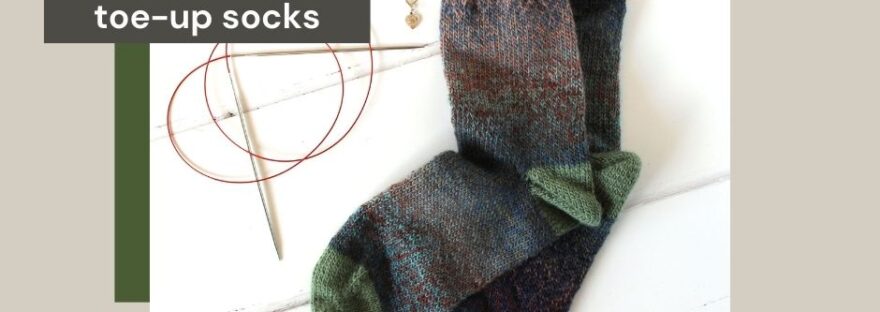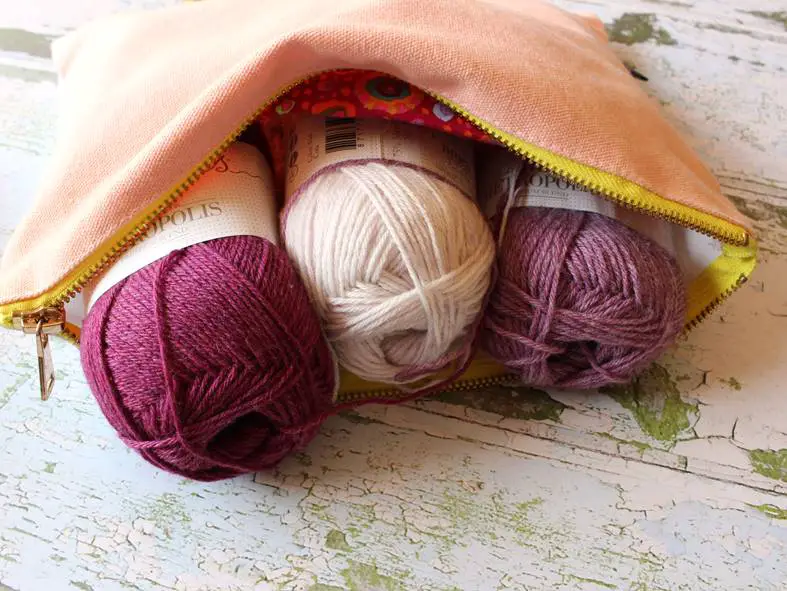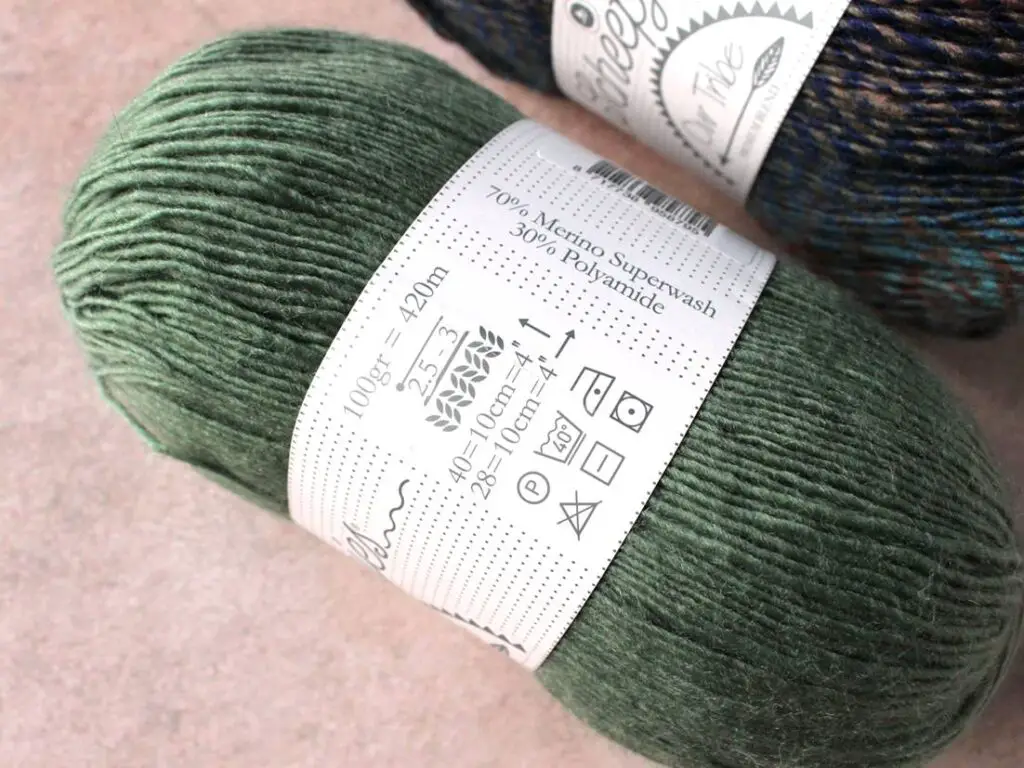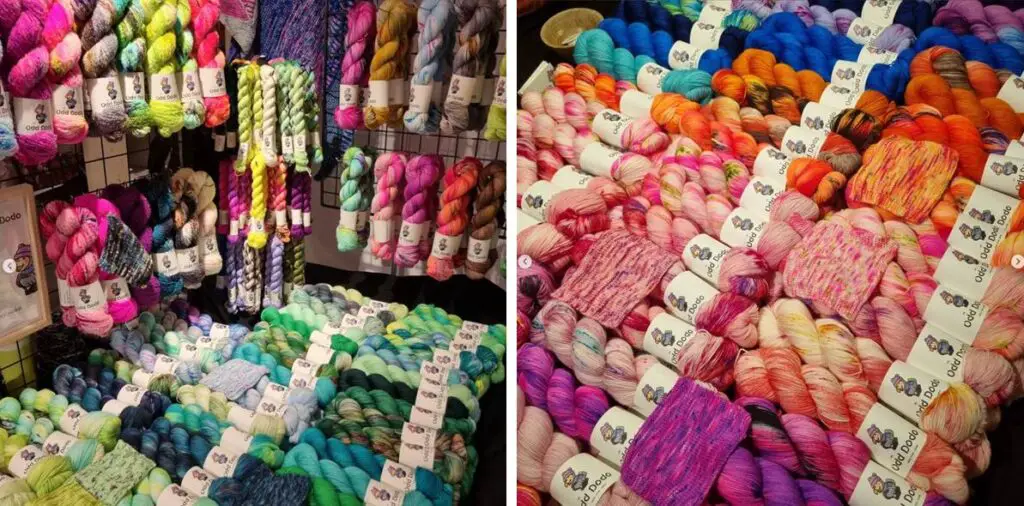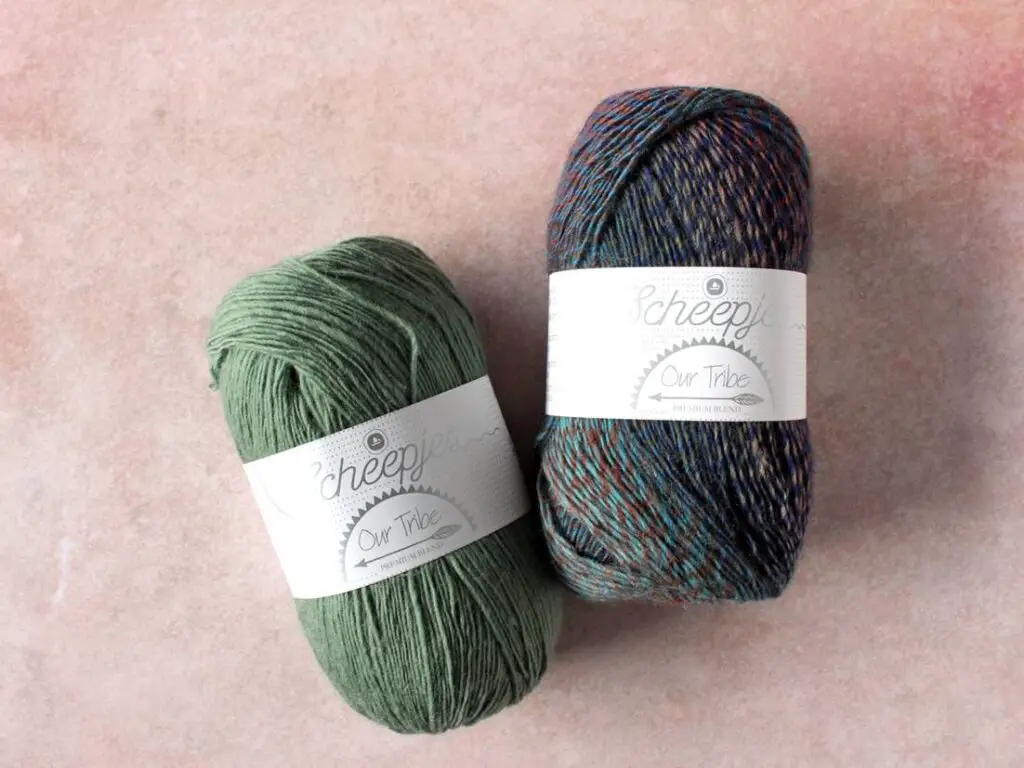In this first part I go into details on what you need when you want to knit socks, but in essence you need two things; sock yarn and knitting needles that are the correct thickness for your yarn and guage.
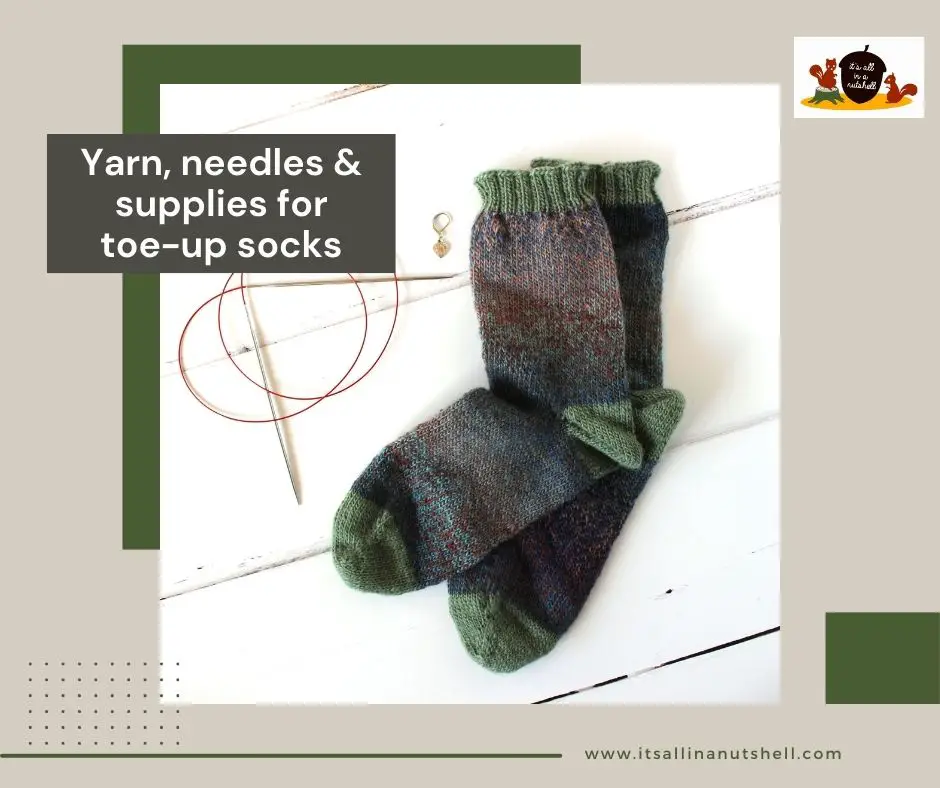
Resources
Overview of materials needed for knitting socks
In general, you need the following materials to knit socks.
- Sock yarn
- Circular knitting needles with cable
- Double Pointed Needles (DPNs)
- Stitch markers, scissors, darning needle
I use the following materials in the video tutorials
- Scheepjes Our Tribe Olive Wreath (879)
- Scheepjes Our Tribe Marie (962)
- 2.5mm circular needles with 75cm cable
- 2.5mm Double Pointed Needles (DPNs) length 15cm
- stitch markers & darning needle
Video Tutorial
In the first video in the series I show the essentials needed to knit socks. I also shortly discuss important things to look for when choosing yarn for your socks.
What is Sock Yarn?
To knit socks the first obvious thing you need is yarn. When it comes to yarn there is a yarn category called “sock yarn”. Sock yarn has several unique characteristics that make it ideal for creating durable, comfortable, and long-lasting socks. It’s usually found in fingering weight (lightweight) or sport weight (slightly heavier), which are perfect for creating snug, well-fitted socks. If you want really thick and warm socks, then double knit (even heavier) sock yarn is the one to go for!
Sock yarn is typically a blend of fibers designed to withstand wear and tear while maintaining comfort and elasticity. The fiber content of sock yarns are usually a wool for warmth and breathability and nylon/polyamide blend for added durability and stretch, although luxury sock yarns can also contain silk, mohair and other fibers.
Wool can come from any sheep breed, although Merino wool is the most common to my experience. Merino wool is often preferred for sock yarn because it’s soft and warm. It keeps your feet comfortable by regulating temperature and drawing moisture away from the skin. The nylon, also called polyamide, adds strength to the yarn, which will make the socks more durable to survive daily use. They also contribute to the yarn’s elasticity, allowing the socks to stretch and fit comfortably.
Superwashed Sock Yarn
Sometimes sock yarns are treated with something called superwash. Superwash yarn is wool that has been treated to prevent felting and shrinking in the wash. Wool fibers naturally have scales that can interlock when agitated, especially in hot water, causing felting. The superwash process smooths these scales, either by coating the wool with a thin layer of polymer or by chemically treating the fibers to remove the scales entirely. The result is a wool yarn that retains the softness, warmth, and elasticity of traditional wool but with the added benefit of being machine-washable and less prone to felting. A downside of the superwash treatment is that the yarn becomes a little less “bouncy”.
Choosing the “Right” Sock Yarn
When selecting sock yarn, consider both the fiber content and the weight of the yarn. A common ratio for sock yarn is about 75% wool and 25% nylon, offering the right balance between comfort and durability. It’s also important to pick yarn that is machine washable, as socks need to withstand regular laundering.
At the same time, you can knit socks from a lot of different types of yarn. If it works for you, then it’s the right yarn for you.
Colors, Self-Patterning and Hand-Dyed Sock Yarn
One of the most exciting aspects of knitting socks is the vast array of colors available. Sock yarn comes in everything from subtle solids to bold multicolored color explosions, allowing you to create unique and eye-catching socks with minimal effort.
Solid-colored sock yarn is uniform color throughout the entire skein and is perfect for when you want a smooth, consistent color that highlights stitch patterns. Solid yarns also pair well with multicolored yarns.
Self-striping yarn is dyed in long color repeats that form stripes as you knit. These stripes emerge naturally without the need to switch yarns, creating colorful bands of color across your socks. Depending on the length of the color repeats, you can get thick or thin stripes. Self-striping yarn is a favorite of mine for easy projects where the yarn does all the colorwork.
Gradient and variegated yarn is a variation on self-striping yarn. Gradient yarn changes smoothly from one color to another over the course of the skein. Unlike self-striping yarn, where stripes are distinct, gradient yarn creates a gradual fade between colors, offering a soft, blended effect. Variegated yarn has multiple short color repeats, resulting in a more speckled or marbled effect where the colors often change quickly and randomly.
There are many independent yarn dyers that make the most beautiful color combinations, perfect for knitting colorful socks. If you are looking for highly vibrant sock yarn, then yarn from The Odd Dodo is exactly what you need. This yarn just screams happy energy to me. Personally I believe life it too short for boring socks!
All in all, don’t shy away from choosing colors that speak to you. Whether you love bold, saturated colors or prefer subtle, muted tones, the right yarn color will make your knitting experience more enjoyable.
Sock yarn used in video tutorials
In the video tutorials I use Scheepjes Our Tribe yarn in two colors. I use the solid Olive Wreath (879) for the toe, heel, and cuff, and I use the color changing Marie (962) for the foot and leg of the sock. This yarn is available in many different gradient color combinations and matching solid colors. The Our Tribe is a bit of a fuzzy yarn, but if you are looking for a more clean yarn, Scheepjes Metropolis could be what you are looking for.
Scheepjes Our Tribe is available from Wool Warehouse (UK/Int), Love Crafts (USA), Caro’s Atelier (NL/EU) or your favorite Scheepjes Stockist.
Scheepjes Metropolis yarn is available from Wool Warehouse (Ships International) and Caro’s Atelier (NL/EU) and well as many other Scheepjes Stockists.
Knitting Needles and other supplies
There are two options for needles when knitting socks; a set of double pointed needles known as DPNs or circular needles with a cable.
DPNs are a set of 5 short, straight needles with points at both ends and are the traditional method for knitting socks. The socks are knitted in the round by distributing the stitches across three or four needles, while using the remaining needle to knit. Handling multiple needles at the same time can be fiddly for beginners, and in all honestly, I have never even tried using DPNs for socks because it looks like a lot of trouble to me. I do however use DPNs to knit the heels on my socks, but that is only a short part of the whole sock and is knitted back-and-forth, as opposed to in the round.
Circular needles consist of two needle tips connected by a flexible cable that is used to divide the sock stitches into two halves and knit them in the round by pulling out sections of the cable. This is my preferred method of knitting socks and is how I will show you to knit in the subsequent video tutorials. I find it easier to manage all the stitches, and there is less risk of losing stitches because the cable helps to keep everything where it should be.
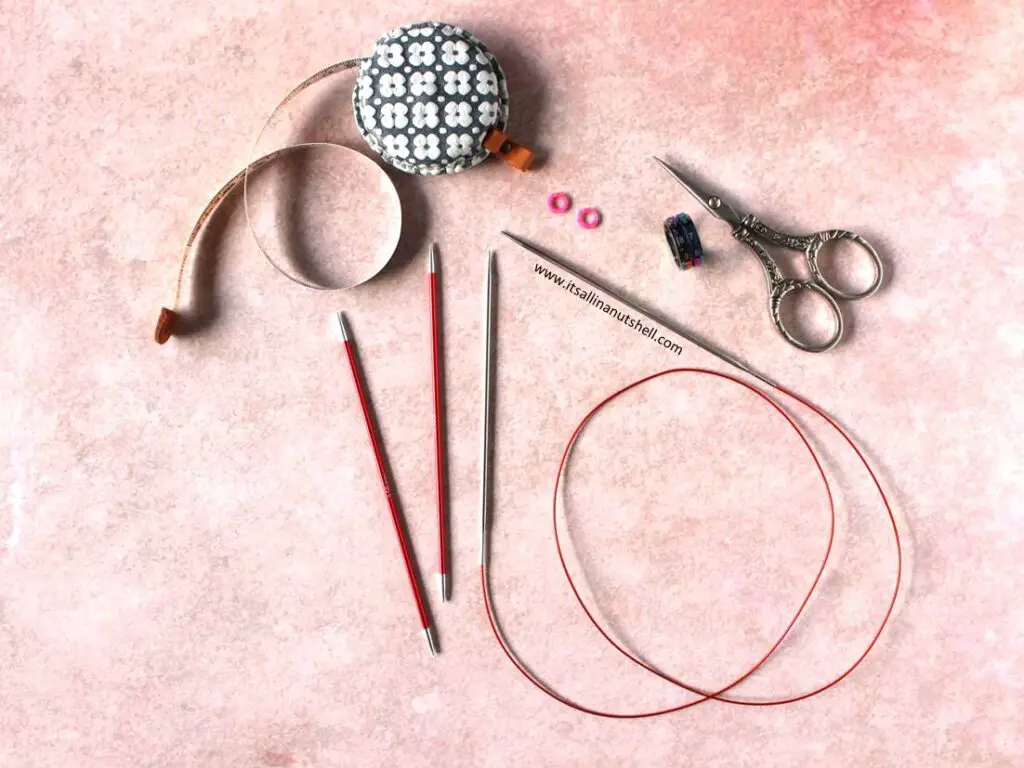
My favorite knitting needles are ChiaoGoo stainless steel needles with the red cable. I have used other needle materials, brands and cables, but somehow I always return to these. ChiaoGoo knitting needles are available from Jimmy Beans Wools.
The thickness of the needles you need depends on the thickness of your yarn and your gauge. Usually, socks are knitted on needles ranging from 2.5mm to 3.5mm.
Other Supplies
Other small things that I always have at hand when knitting socks are stitch markers (both those that can open up and those that can’t), a measuring tape, needle cosy, scissors and a darning needles. And off course, everything tucked away nicely in a small project bag, ready to take with me at a moments notice.
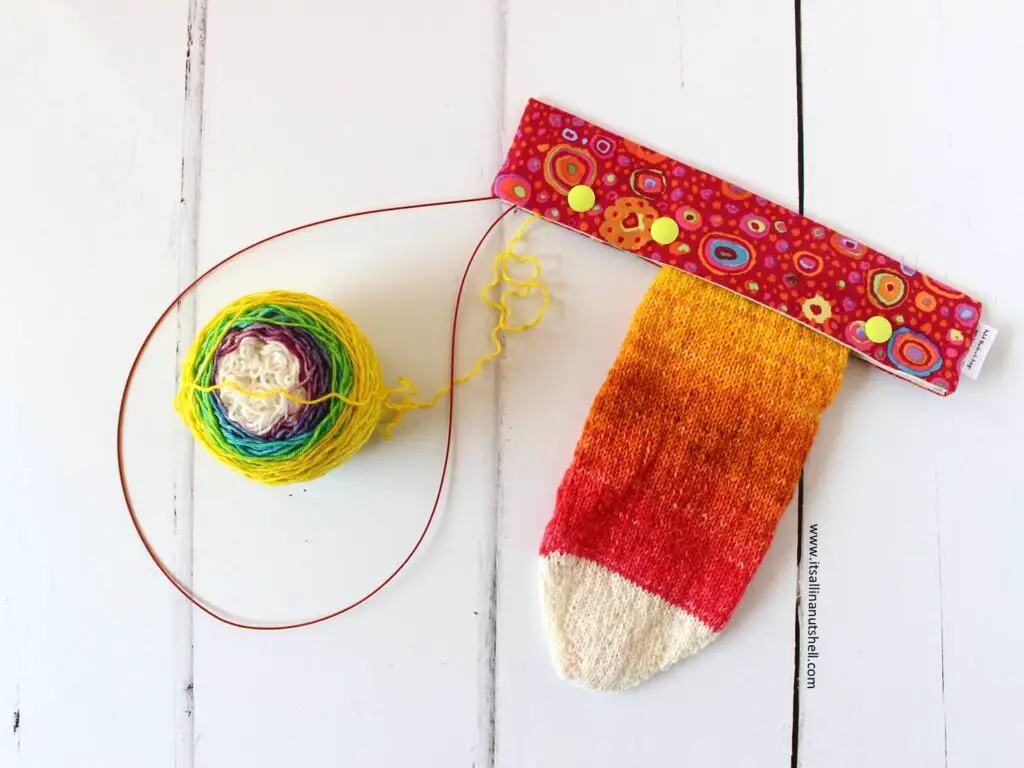
Socks really are the perfect project to take with you when traveling because they don’t take up a lot of space and once you get the hang of it, they are super relaxing to make.
Support me and my work
There are many ways that you can support me and my work and most of them are free. By visiting my website you are already supporting me! Also by viewing any of the free videos on my YouTube channel you support me.
Other ways to support me are to make a purchase from one of my affiliates. I get a small commission based on your purchase after you click one of the links on my website. It costs you absolutely nothing but helps me a lot. My affiliates are Amazon.co.uk, KnitPicks, Wool Warehouse, Jimmy Beans Wool, Minerva Craft, The Knitting Network, Love Crafts, and Caro’s Atelier.
If you would like to support me in ways that are out of pocket for you, you could buy any of my patterns on Ravelry or my SHOP. You can also make a DONATION, which I really appreciate. Even a small amount helps me to keep my small business running.
#itsallinanutshell
If you are making something with one of my patterns or one of my videos, I would love to see your work. Use the hashtag #itsallinanutshell on Instagram to help me find it, share your work in my It’s all in a Nutshell Crochet Nuts group on Facebook or tag me in one of your posts.
With love,
Esther
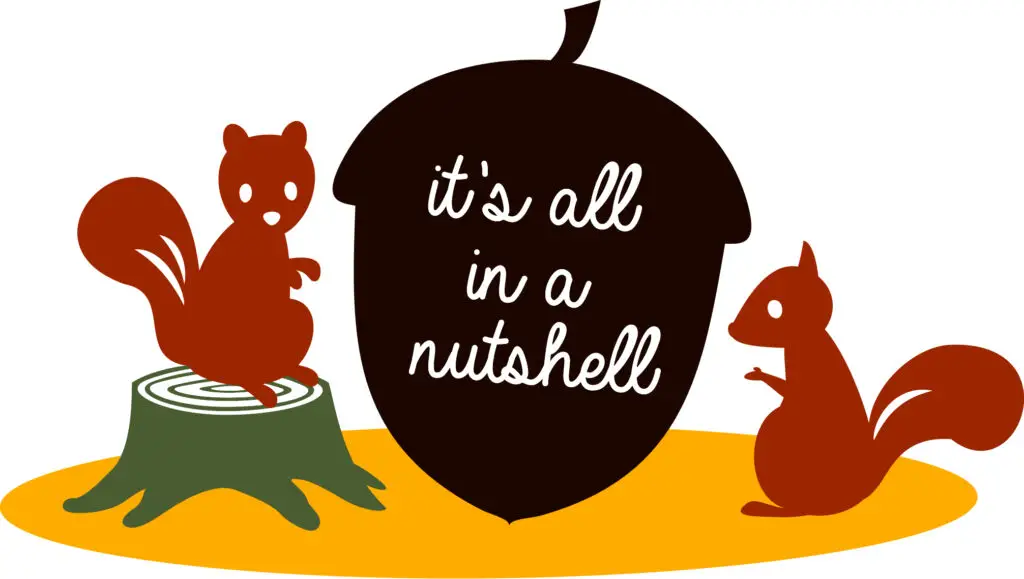
Follow me on
Facebook, YouTube, Ravelry, Instagram
This post contains affiliate links. Please read my disclosure and copyright policy. All opinions are my own and I only link to products I use or would use. Thank you for using the links on my blog and supporting my work.
Copyright (c) 2014-2025 It’s all in a Nutshell Creations. All rights reserved.
Discover more from It's all in a Nutshell Crochet
Subscribe to get the latest posts sent to your email.

